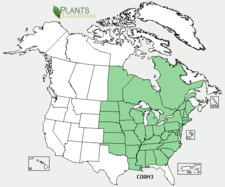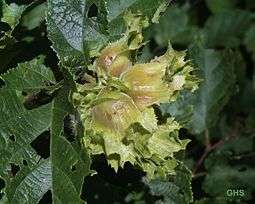Corylus americana
| Corylus americana | |
|---|---|
 | |
| Scientific classification | |
| Kingdom: | Plantae |
| (unranked): | Angiosperms |
| (unranked): | Eudicots |
| (unranked): | Rosids |
| Order: | Fagales |
| Family: | Betulaceae |
| Genus: | Corylus |
| Species: | C. americana |
| Binomial name | |
| Corylus americana Marshall, 1785 | |

Corylus americana, the American Hazelnut, is a species of deciduous plant that grows in the form a shrub; it is native to eastern North America, in eastern Canada and the Eastern United States; it has been classed within the genus Corylus.[1]
Description
The plant grows to a height of roughly 2.5 m to 5 m (8–16 feet),[2] with a crown spread of 3 m to 4.5 m (10–15 feet). It is a medium to large shrub, which under some conditions can take the like of a small tree. It is often multi-stemmed with long outward growing branches that form a dense spreading or spherical shape.
American hazelnut produces edible nuts that mature at a time between July and October, these are encased in bracts with a leaf-like cover.
Ecology
The nuts produced by American hazelnut are a mast of squirrels, deer, turkey, woodpeckers, pheasants and other animals. The male catkins are a food staple of ruffed grouse throughout the winter.
Uses
The nuts are edible, although smaller than the more commonly cultivated filberts (Corylus maxima,[1][3] Corylus colurna,[1] Corylus avellana,[3] and hybrids thereof[3]).
Native Americans used Corylus americana for medicinal purposes.[4]

Cultivation
Corylus americana is cultivated as an ornamental plant for native plant gardens, and in wildlife gardens to attract and keep fauna in an area. There are cultivated hybrids of Corylus americana with Corylus avellana which aim to combine the larger nuts of the latter with the former's resistance to a North American fungus Cryptosporella anomala.[3]
It is a medium to fast-growing species, that suckers moderately, eventually producing a multi-stemmed, clump appearance.
It adapts well to a range of soil pH and types, but does best on well-drained loams. American hazelnut prefers full sun for best growth and development. Though it can grow and persist in partial shade, plant density and fruit production are greatly reduced.
References
- 1 2 3 1. Corylus americana Walter, Flora of North America
- ↑ "Corylus americana". http://www.missouribotanicalgarden.org/. Missouri Botanical Garden. Retrieved 2016-07-05. External link in
|website=(help) - 1 2 3 4 "Filbert", Hortus Third, 1976, p. 479, ISBN 0-02-505470-8
- ↑ Corylus americana Marshall, GRIN Taxonomy for Plants
External links
 Media related to Corylus americana at Wikimedia Commons
Media related to Corylus americana at Wikimedia Commons- Corylus americana Photos, drawings, description from Nature Manitoba.